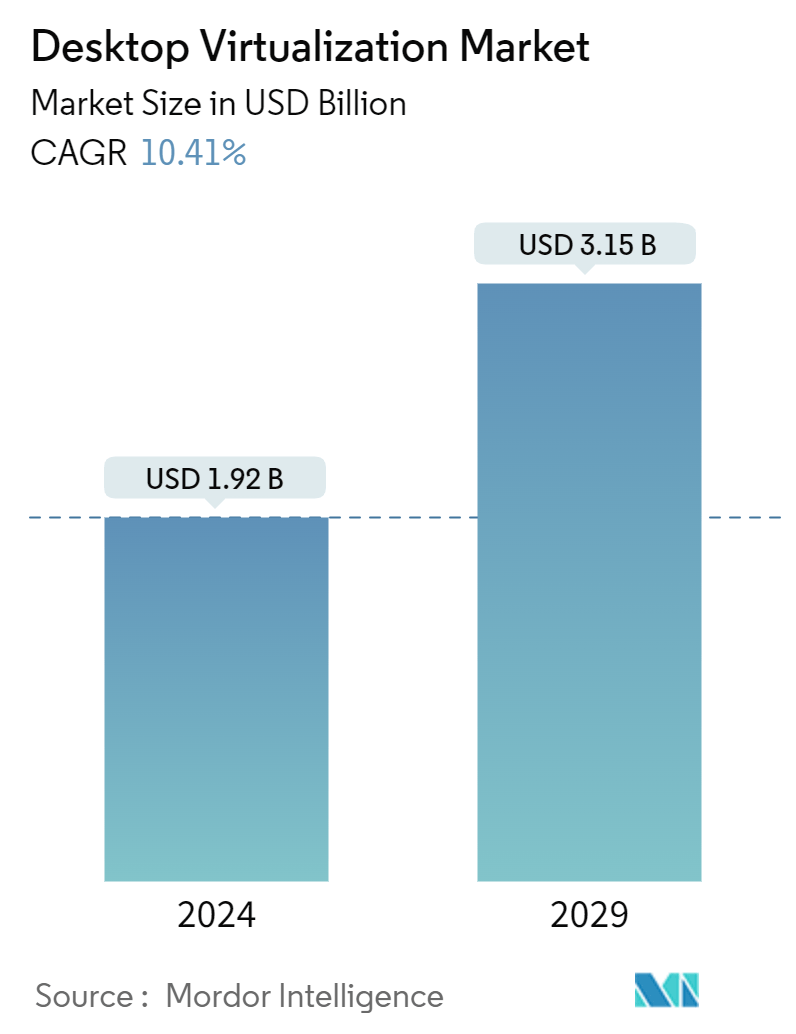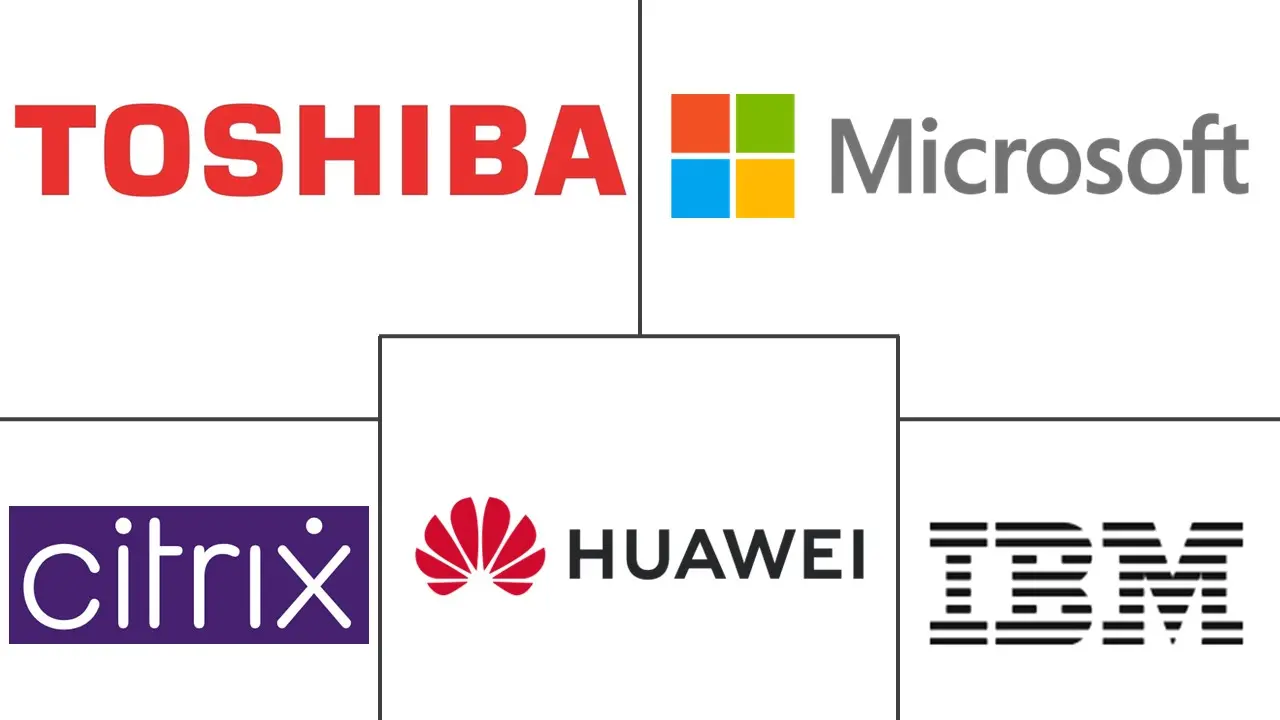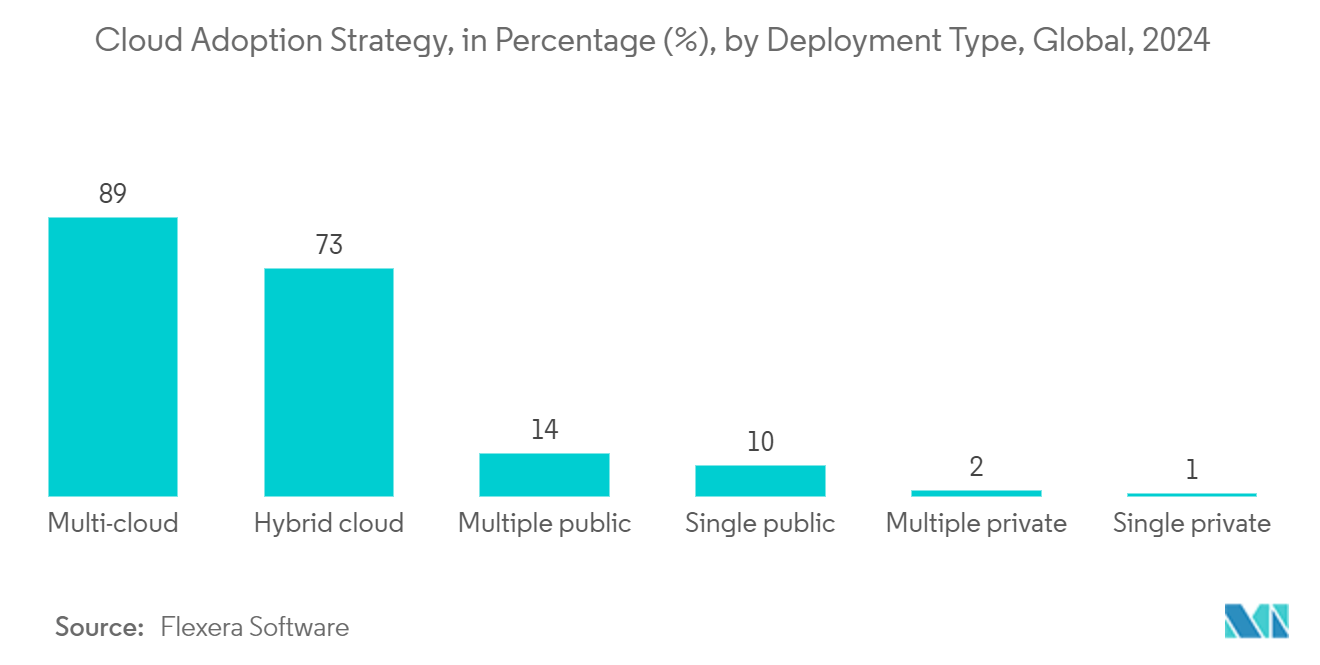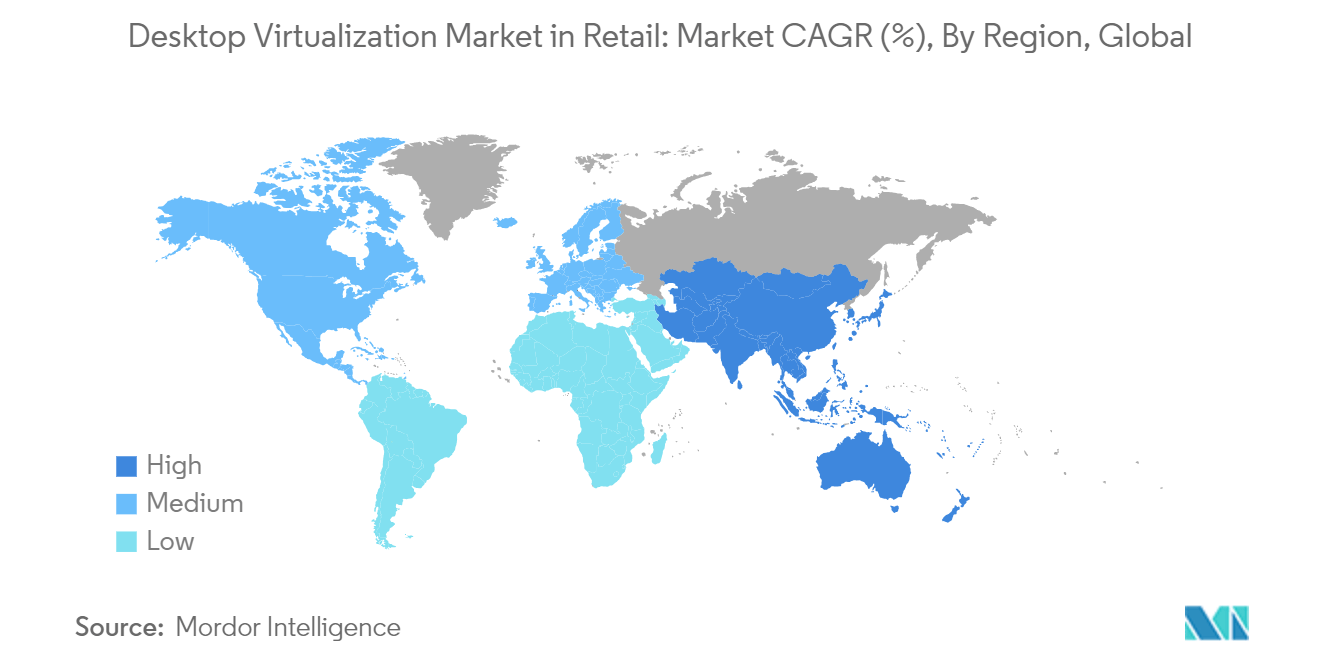Retail Desktop Virtualization Market Size

| Study Period | 2019 - 2029 |
| Market Size (2024) | USD 1.92 Billion |
| Market Size (2029) | USD 3.15 Billion |
| CAGR (2024 - 2029) | 10.41 % |
| Fastest Growing Market | Asia Pacific |
| Largest Market | North America |
Major Players
*Disclaimer: Major Players sorted in no particular order |
Retail Desktop Virtualization Market Analysis
The Desktop Virtualization Market size is estimated at USD 1.92 billion in 2024, and is expected to reach USD 3.15 billion by 2029, growing at a CAGR of 10.41% during the forecast period (2024-2029).
The desktop virtualization market has gained significant traction, driven by the rapid adoption of cloud computing and increasing automation across various sectors. Desktop virtualization, which involves running a desktop operating system within a virtual machine (VM) hosted on a centralized server, has become a crucial solution for businesses aiming to enhance flexibility, security, and cost efficiency. This technology, often delivered through platforms like Virtual Desktop Infrastructure (VDI) or Desktop as a Service (DaaS), enables remote desktop solutions and application virtualization, fostering a seamless virtual workspace.
Industry analysis reveals that desktop virtualization is becoming increasingly integral to modern IT infrastructures, especially with the rise of multi-cloud environments and the growing demand for end-user computing (EUC) solutions. Virtual machines (VMs) and software-defined data centers (SDDCs) are also playing a pivotal role in this landscape, enabling organizations to deploy virtual desktops efficiently. With companies like Citrix Systems Inc., VMware Inc., and Microsoft Corporation leading the market, the competition is intense, with significant innovation occurring in hyper-converged infrastructure (HCI) and thin clients.
As businesses continue to prioritize flexibility and remote work capabilities, the demand for virtual desktop deployment is expected to grow. The market outlook suggests a steady rise in the adoption of cloud desktops, particularly in industries where data security and accessibility are paramount. This shift is reflected in the market's segmentation, with a noticeable trend towards cloud deployment modes over on-premise solutions, particularly in regions like North America and Europe.
Cloud Computing's Role in Driving Desktop Virtualization
- Transformation of IT Infrastructure: Cloud computing has transformed traditional IT infrastructures, making desktop virtualization a feasible solution for businesses of all sizes. By leveraging cloud-based services, companies can deploy virtual desktops more efficiently, reducing the need for extensive physical infrastructure. This shift has been instrumental in enabling the scalability of virtual desktop infrastructure (VDI) and Desktop as a Service (DaaS) solutions. The flexibility offered by cloud desktops allows organizations to manage resources dynamically, which is particularly advantageous in multi-cloud environments where workload distribution and disaster recovery are critical.
- Enhanced Accessibility and Cost Efficiency: Cloud computing facilitates greater accessibility and cost efficiency, enabling organizations to support remote desktop solutions and application virtualization without significant upfront investment. With the proliferation of virtual machines (VMs), businesses can provide employees with secure and consistent access to virtual workspaces, regardless of location. This capability is essential in today’s work-from-anywhere culture, where mobility and data security are top priorities. Moreover, cloud desktops allow for more straightforward management and updates, which reduces the total cost of ownership (TCO) compared to traditional desktop setups.
Automation in Retail Boosting Virtualization Demand
- Streamlining Retail Operations: The growth in automation within the retail sector is significantly contributing to the demand for desktop virtualization. Retailers are increasingly adopting automation technologies to streamline operations, enhance customer experience, and improve supply chain efficiency. Desktop virtualization supports these efforts by providing a centralized platform for managing applications, inventory systems, and customer data across multiple locations. By implementing remote desktop solutions, retailers can ensure that their operations are synchronized, with real-time data access and processing capabilities that are critical in a fast-paced environment.
- Supporting Omnichannel Strategies: As retailers continue to develop omnichannel strategies, the need for seamless integration across physical and digital platforms becomes more pronounced. Desktop virtualization enables retailers to create a unified workspace that supports various functions, from point-of-sale (POS) systems to customer relationship management (CRM) tools. This integration is vital for delivering a consistent customer experience across channels. Additionally, with the rise of virtual desktop deployment, retailers can maintain robust security protocols and data protection measures, which are essential in handling sensitive customer information.
Retail Desktop Virtualization Market Trends
The Rise of Cloud Deployment in Desktop Virtualization
- Cloud Deployment Trends: Cloud deployment has become a pivotal trend in the desktop virtualization market, driven by the need for cost-effective, scalable, and easily managed solutions. Businesses are increasingly transitioning from traditional on-premise setups to cloud-based models, with Virtual Desktop Infrastructure (VDI) and Desktop as a Service (DaaS) leading the way. This shift allows companies to deploy virtual desktops swiftly while reducing upfront costs and enhancing flexibility. The adoption of multi-cloud environments is further accelerating this trend, as businesses seek to avoid vendor lock-in and enhance operational resilience, driving the proliferation of virtual machines (VMs) across various cloud platforms.
- Key Factors Boosting Cloud Deployment: The widespread adoption of cloud computing is transforming the desktop virtualization landscape, offering organizations the ability to manage resources more efficiently. The growing preference for cloud deployment is due to the seamless integration of computing, storage, and networking resources provided by hyper-converged infrastructure (HCI). Additionally, the rise of Software-Defined Data Centers (SDDCs) is making it easier for enterprises to manage virtualized workloads, significantly improving operational efficiency. As a result, small to medium-sized enterprises (SMEs) are increasingly embracing cloud desktop solutions to optimize their IT resources, further driving market growth.

North America is Expected to Hold Major Share
- North America Leading the Global Market: North America is set to dominate the desktop virtualization market, driven by its advanced technological infrastructure and high adoption rates of digital transformation strategies. The region's strong focus on innovation and its ability to rapidly integrate new technologies have positioned it as a critical hub for market growth. The increasing demand for remote desktop solutions, fueled by the rise in remote work and telecommuting, is a key factor supporting this dominance. As businesses across the region adopt VDI, DaaS, and cloud desktop solutions, North America’s market share is expected to grow significantly.
- United States as a Key Player: The United States, as the largest consumer of desktop virtualization in North America, plays a crucial role in the region's market leadership. The presence of major cloud service providers and an increasing number of hosted servers in the U.S. are driving the growth of cloud-based desktop virtualization. Additionally, the proximity to Canada and the emphasis on eco-friendly practices in new workspaces are further bolstering the market’s expansion across the region. This regional interconnectivity supports the broader adoption of desktop virtualization solutions, reinforcing North America's leadership position.

Retail Desktop Virtualization Industry Overview
Highly Fragmented Market: The desktop virtualization market is highly fragmented, with no single company holding a dominant market share. This fragmentation indicates a competitive environment where both large global corporations and smaller specialized companies operate. The market's nature reflects the diversity of end-user needs, with players offering a wide range of solutions from basic virtualization to complex, customized deployments.
Market Leaders with Diverse Approaches: The leading players in the desktop virtualization market include Citrix Systems Inc., Toshiba Corporation, Red Hat Inc. (IBM Corporation), Huawei Technologies Co. Ltd., and Microsoft Corporation. These companies are distinguished by their strong global presence, extensive product portfolios, and continuous innovation. Citrix and Microsoft are particularly noted for their comprehensive virtualization platforms, while Red Hat (under IBM) and Huawei focus on integrating open-source and cloud-based solutions. Toshiba’s presence is more niche, catering to specific industry needs.
Future Success Strategies Revolve Around Innovation and Integration: Key trends in the desktop virtualization market include the growing demand for cloud-based solutions, security enhancements, and seamless integration with existing IT infrastructures. For market players to succeed, they must focus on these areas, providing flexible and secure solutions that can adapt to the changing needs of businesses. Continuous innovation, strategic partnerships, and expanding service offerings will be crucial strategies for staying competitive in this fragmented market.
Retail Desktop Virtualization Market Leaders
-
Citrix Systems Inc.
-
Toshiba Corporation
-
Red Hat Inc. (IBM Corporation )
-
Huawei Technologies Co. Ltd
-
Microsoft Corporation
*Disclaimer: Major Players sorted in no particular order

Retail Desktop Virtualization Market News
- August 2024 - Citrix announced that integrating Amazon WorkSpaces Core with Citrix DaaS presents a cost-effective solution. The control plane plays a pivotal role in managing the compute layer of AWS workloads, ensuring optimized HDX apps are accessible from anywhere. Together, Amazon WorkSpaces Core and Citrix boost cost efficiency, simplify cloud management, and elevate user experiences.
- July 2024 - Microsoft has rolled out a public preview of its revamped optimization architecture for Microsoft Teams on Azure Virtual Desktop. Simultaneously, Windows 365 has been made accessible to all users. This redesign seeks to align the features of Teams for VDI more closely with those of the native Teams, focusing on enhanced speed, automatic updates, and streamlined support.
- July 2024 - Ensono announced the expansion of its Microsoft Azure Virtual Desktop (AVD) Specialization. This milestone underscores Ensono's dedication to premier cloud solutions and its expertise in managing and enhancing virtual desktop environments on Microsoft Azure.
Retail Desktop Virtualization Market Report - Table of Contents
1. INTRODUCTION
- 1.1 Study Assumptions and Market Definition
- 1.2 Scope of the Study
2. RESEARCH METHODOLOGY
3. EXECUTIVE SUMMARY
4. MARKET INSIGHTS
- 4.1 Market Overview ( Includes the Impact due to COVID-19)
-
4.2 Industry Attractiveness - Porter's Five Forces Analysis
- 4.2.1 Bargaining Power of Buyers/Consumers
- 4.2.2 Bargaining Power of Suppliers
- 4.2.3 Threat of New Entrants
- 4.2.4 Threat of Substitute Products
- 4.2.5 Intensity of Competitive Rivalry
5. MARKET DYNAMICS
-
5.1 Market Drivers
- 5.1.1 Increasing Adoption of Cloud Computing
- 5.1.2 Growth in Automation in Retail
-
5.2 Market Restraints
- 5.2.1 Infrastructure Deployment Constraints
6. MARKET SEGMENTATION
-
6.1 By Desktop delivery platform
- 6.1.1 Hosted Virtual Desktop (HVD)
- 6.1.2 Hosted Shared Desktop (HSD)
-
6.2 By Deployment Mode
- 6.2.1 On-premise
- 6.2.2 Cloud
-
6.3 By Geography***
- 6.3.1 North America
- 6.3.2 Europe
- 6.3.3 Asia
- 6.3.4 Australia and New Zealand
- 6.3.5 Latin America
- 6.3.6 Middle East and Africa
7. COMPETITIVE LANDSCAPE
-
7.1 Company Profiles*
- 7.1.1 Citrix Systems Inc.
- 7.1.2 Toshiba Corporation
- 7.1.3 Red Hat Inc. (IBM Corporation )
- 7.1.4 Huawei Technologies Co. Ltd.
- 7.1.5 Microsoft Corporation
- 7.1.6 Parallels International GmbH
- 7.1.7 Dell Inc.
- 7.1.8 Ncomputing, Inc.
- 7.1.9 Ericom Software Inc.
- 7.1.10 Tems, Inc
- 7.1.11 Vmware Inc.
8. INVESTMENT ANALYSIS
9. FUTURE OF THE MARKET
** Subject To AvailablityRetail Desktop Virtualization Industry Segmentation
Desktop virtualization separates the physical client device from its operating system. Instead of being stored locally, desktop data resides on a centralized or remote server. This setup enables users to access their data anytime and from anywhere. Retail companies stand to gain significantly from Virtual Desktop Infrastructure (VDI). With VDI, retailers can conveniently manage their vast enterprise networks, comprising thousands of devices, directly from their browsers.
The desktop virtualization market in retail is segmented by desktop delivery platform (hosted virtual desktop (HVD) and hosted shared desktop (HSD)), by deployment mode (on-premises and cloud), and by geography (North America, Europe, Asia Pacific, Latin America, Middle East and Africa). The report offers market forecasts and size in value (USD) for all the above segments.
| By Desktop delivery platform | Hosted Virtual Desktop (HVD) |
| Hosted Shared Desktop (HSD) | |
| By Deployment Mode | On-premise |
| Cloud | |
| By Geography*** | North America |
| Europe | |
| Asia | |
| Australia and New Zealand | |
| Latin America | |
| Middle East and Africa |
Retail Desktop Virtualization Market Research FAQs
How big is the Retail Desktop Virtualization Market?
The Retail Desktop Virtualization Market size is expected to reach USD 1.92 billion in 2024 and grow at a CAGR of 10.41% to reach USD 3.15 billion by 2029.
What is the current Retail Desktop Virtualization Market size?
In 2024, the Retail Desktop Virtualization Market size is expected to reach USD 1.92 billion.
Who are the key players in Retail Desktop Virtualization Market?
Citrix Systems Inc., Toshiba Corporation, Red Hat Inc. (IBM Corporation ), Huawei Technologies Co. Ltd and Microsoft Corporation are the major companies operating in the Retail Desktop Virtualization Market.
Which is the fastest growing region in Retail Desktop Virtualization Market?
Asia Pacific is estimated to grow at the highest CAGR over the forecast period (2024-2029).
Which region has the biggest share in Retail Desktop Virtualization Market?
In 2024, the North America accounts for the largest market share in Retail Desktop Virtualization Market.
What years does this Retail Desktop Virtualization Market cover, and what was the market size in 2023?
In 2023, the Retail Desktop Virtualization Market size was estimated at USD 1.72 billion. The report covers the Retail Desktop Virtualization Market historical market size for years: 2019, 2020, 2021, 2022 and 2023. The report also forecasts the Retail Desktop Virtualization Market size for years: 2024, 2025, 2026, 2027, 2028 and 2029.
Retail Desktop Virtualization Industry Report
Our industry research on the desktop virtualization market delivers a comprehensive analysis of current trends, key drivers, and competitive dynamics. This report provides stakeholders with crucial insights into the factors influencing the market's growth, including the rising adoption of cloud desktops, the shift towards multi-cloud environments, and the increasing demand for end-user computing (EUC) solutions. The analysis highlights the roles of leading players like Citrix Systems Inc. and VMware Inc., focusing on their strategies in areas such as hyper-converged infrastructure (HCI) and software-defined data centers (SDDCs). With a detailed examination of market segmentation and geographic trends, the report offers a strategic perspective on the industry's future direction.
For businesses and investors, our industry report presents valuable information on market trends, including the growing preference for virtual desktop deployment over on-premise solutions and the expanding role of automation in various sectors. This report pdf serves as an essential resource for decision-makers, providing actionable data and industry statistics that support informed strategic planning. The comprehensive market overview, coupled with expert analysis, ensures that stakeholders are well-equipped to navigate the evolving landscape of the desktop virtualization market.
Statistics for the 2024 Desktop Virtualization market share, size and revenue growth rate, created by Mordor Intelligence™ Industry Reports. Desktop Virtualization analysis includes a market forecast outlook to for 2024 to 2029 and historical overview. Get a sample of this industry analysis as a free report PDF download.



